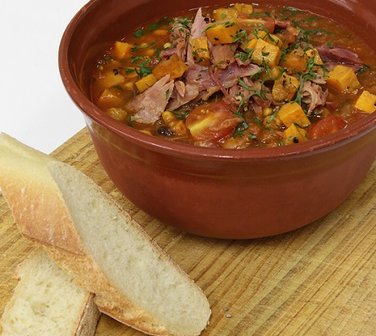Hail the new super food
Lupins are the new super food. High in antioxidants, low in carbohydrates, gluten-and-GMO free, they’re rich in protein and high in fibre for one of the healthiest ingredients around.
“When you stack them up against quino and chai, they’ve actually got more nutritional value than either of those two, ” Lupin Foods Australia’s Tom Puddy said.
We’re talking about the narrow-leafed Australian sweet lupin — Lupines angustifolius — not the Mediterranean Albus variety that produces lupini beans.
The CBH Group-owned company has invested a lot of time and money researching the benefits of this versatile legume that was consumed by ancient civilisations and has been used as animal feed for 25-30 years in WA, which grows about 80 per cent of the world’s commercial crops. That’s 300,000-500,000 tonnes annually. Farmers like it because it puts nitrogen back into the soil, making it an important part of their crop- rotation regime.
“It’s a sustainable way of farming, ” Mr Puddy said. “When farmers grow wheat, barley and canola, that takes nitrogen out of the soil. They might grow three crops in a row, then they’ll put in lupins to balance things out.”
Lupin Foods Australia took out this year’s coveted Australian Institute of Food Science and Technology’s Food Industry Innovation Award. It was also named winner for best new environmentally sustainable initiative and runner-up for best new health food or beverage at Gulfood 2014 in Dubai, the biggest food and hospitality exhibition in the world.
Topping off a stellar run, lupins stole the show at Buy West Eat Best’s inaugural WA Signature Dish competition, with Lupin Foods Australia digital marketing officer Rhiannon Birch winning the final cook-off on WA Day with her lupin flake and za’atar crumbed Dorper lamb cutlets with Moroccan sweet potato salad.
“It’s just such a versatile ingredient because it lends itself to vegetarian foods, crumbing of meat or fish and is great for breakfast dishes, like muesli and oats, ” Ms Birch said. “It can be eaten by people with food intolerances because it’s gluten free and has a low GI. The health benefits are outstanding when you consider it’s 40 per cent protein and 37 per cent fibre, which gives it a unique nutritional profile.”
The flakes were launched a few months ago and are already making their way on to menus around town. Bib & Tucker, in Leighton, is using them in a fritter; Fraser’s, in Kings Park, has done an eggplant crumb and Pepper & Salt, in Denmark, a chicken crumb.
“I have them every day in porridge and smoothies, ” Mr Puddy said. “They’re a great replacement for chickpeas in hommus, falafel, pitta breads and crumbed meats. For hommus, you can use the flakes instead of chickpeas and I don’t think you can tell the difference because all the other ingredients give it flavour.
“We’re now working to move away from animal feed and introducing lupins to the domestic and international markets as a high-protein, gluten-free food ingredient because there’s more value for growers in producing it for human consumption. We’re already shipping container loads into the Indonesian market, which uses it as an alternative to soy beans to make tempeh, and it’s going to Europe to produce a soy sauce equivalent. We’re working to do the same in north Asia.”
© The West Australian
More Lifestyle and food news: thewest.com/lifestyle/food









